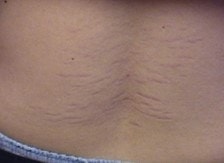One of the most difficult parts of experiencing symptoms of Lyme disease is getting a proper diagnosis, let alone treatment. Many of the symptoms of Lyme disease, as well as other tick-borne diseases, can be non-specific and difficult to pin down – especially if someone is unsure of whether or not they’ve been bitten by a tick.
A symptom that is, however, specific to Lyme disease is the erythema migrans rash, also known as the “bull’s eye rash.” Lyme disease can be diagnosed based on the presence of this rash alone. However, this depends on the patient’s and physician’s ability to correctly recognize the rash – if it shows up at all.
So, what exactly is erythema migrans, is it a telltale sign of Lyme disease, and how does it compare to other rashes? We’re here to break down these questions and give you vital information about Lyme disease and your health.
What does erythema migrans look and feel like?
Erythema migrans in Lyme disease is typically one of the first symptoms that pop up – if it does present itself at all. About 3 to 30 days after someone is bitten by an infected tick, they may develop a rash that looks like a circular red area, sometimes clear in the middle, hence the nickname “bull’s eye rash.” This usually first shows up at the site of the tick bite.

Image source: https://commons.wikimedia.org/wiki/File:Bullseye_Lyme_Disease_Rash.jpg
The CDC reports that erythema migrans rash occurs in about 70-80% of patients with Lyme disease. This conflicts with other data, however, showing that the traditional bull’s eye rash is actually much less common, showing up in only 25-50% of cases. (PDF) The discrepancy may be partially due to the fact that the bulls-eye pattern itself is only common in a small number of cases. Many people instead develop a blue-red or solid red oval or circle, or no rash at all. It can grow up to 12 inches across, expanding gradually after the initial appearance of the rash.
The rash can take alternate forms with blue-purple hues, solid lesions, or crusted and blistering lesions. Erythema migrans is not usually itchy or painful, but it may be warm to the touch.
If Lyme disease is not treated early, the rash may appear in more than one place on the body. This is due to spirochetes, or bacteria, spreading throughout the body.
In addition to the erythema migrans rash, Lyme disease also causes symptoms like:
- Headache and body aches
- Fatigue
- Swollen lymph nodes and neck stiffness
- Chills
- Fever
There is some misinformation amongst the medical community when it comes to erythema migrans. Some doctors believe that Lyme can’t be present if an erythema migrans rash isn’t present. However, as we mentioned, this rash does not show up in a large portion of Lyme cases, or it may not look like the standard “bull’s eye rash.” In some patients the rash may be hidden and the patient does not realize they have a rash – for example, if the rash is on the scalp covered by hair. It can also be hard to identify in people with dark skin.
Erythema migrans is a symptom that is specific to Lyme. That being said, it’s not the only tick-borne illness that can cause a rash to develop.

Erythema migrans vs. other rashes
Although erythema migrans is only present in Lyme disease, other tick-borne diseases can also cause rashes, like Bartonellosis and Rocky Mountain Spotted Fever.
The bacteria that causes Bartonellosis can be carried by the same ticks that carry Lyme disease. This disease can cause similar symptoms as Lyme, but the rash it presents is different. The Bartonellosis rash typically causes long red streaks, similar to stretch marks, that are painless and don’t itch.


Bartonella photos taken by Dr. Martin Fried, with thanks to the Lyme Disease Association
Another rash-causing tick-borne illness is Rocky Mountain Spotted Fever, caused by the Rickettsia bacteria. RMSF can be transmitted quickly from an infected tick and is the most deadly tick-borne disease in the world. In addition to symptoms like abdominal pain, fever, headache, and respiratory concerns, people may also develop a rash. The RMSF rash typically looks like red splotches, pinpoint spots, or dots, and is not itchy.

Ticks aren’t the only things you find in the woods that can cause rashes. Non-tick-related rashes can develop after contact with plants like poison ivy or poison oak. These typically look like red, raised blisters, and unlike erythema migrans and other tick-related rashes, can be incredibly itchy and uncomfortable.
Lyme testing and diagnosis
If you live in or are traveling to an area where you may come in contact with ticks, it’s important to be diligent about preventing tick bites by covering yourself, using proper insect repellent, and checking yourself. You can also help protect yourself and your family by staying informed on possible symptoms of tick-borne illnesses, knowing how to properly remove a tick and save it for testing, and of course – knowing where to seek out testing.
When it comes to diagnosing and treating Lyme disease, time is of the essence. Whether or not erythema migrans is present, it’s vital to seek testing for Lyme disease and other tick-borne illnesses as soon as possible since treatment is more effective the sooner it’s .
Most cases of early Lyme disease can be treated through antibiotics if caught early on. Getting timely, accurate testing through a reputable lab like IGeneX is one of the most vital steps you can take to treat and manage Lyme disease and other tick-borne illnesses.








